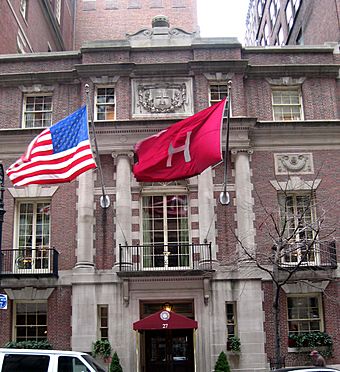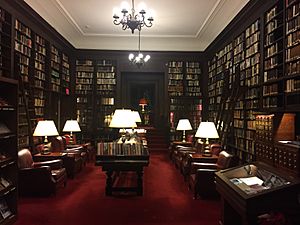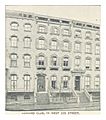Harvard Club of New York City facts for kids
|
Harvard Club of New York City
|
|

The Harvard Club of New York in March 2008
|
|
| Location | 27 West 44th Street, Manhattan, New York |
|---|---|
| Built | 1894; enlarged in 1905, 1915 and 1989 |
| Architect | Charles Follen McKim of McKim, Mead & White |
| Architectural style | Colonial Revival, neo-Georgian style |
| NRHP reference No. | 80002693 |
Quick facts for kids Significant dates |
|
| Added to NRHP | March 28, 1980 |
The Harvard Club of New York City, often called The Harvard Club, is a special private club in Midtown Manhattan, New York City. Only people who have studied at or worked for Harvard University can become members.
The club was officially started in 1887. Its main building is located on West 44th Street. The first part of the building was finished in 1894. It was designed by a famous architect named Charles Follen McKim. The building has a classic red brick style, similar to old Georgian buildings.
Contents
History of the Harvard Club
The Harvard Club was first created in 1865 by a group of Harvard graduates. At first, they didn't have a permanent home. In 1887, they rented a house on 22nd Street to use as their clubhouse. A year later, in 1888, the club bought land on 44th Street. They planned to build a brand new clubhouse there.
The Harvard Club chose architect Charles Follen McKim to design their new building. He was part of the firm McKim, Mead & White. The building was designed in a classic Georgian style. It used special Harvard brick and Indiana limestone. The front of the building, finished in 1894, looks a lot like the gates at Harvard Yard.
Over the years, the club grew bigger. In 1905, new parts were added. These included Harvard Hall, the Grill Room, a new library, and a billiard room. They also added two floors of guest rooms for members.
In 1915, the building was made twice as big. This expansion added a large Main Dining Room and a bar. More guestrooms and banquet halls were also built. The club even added sports facilities, including a swimming pool on the seventh floor.
In 2003, more changes were made. Architects Davis Brody Bond added a large new section. This part of the building has a modern look with limestone and big glass windows.
Women Join the Club
For a long time, the Harvard Club of New York was only for men. In 1970, four women who were students at Harvard Business School tried to join. They were turned away because of the club's rules.
These women, Ellen Marram, Katie Metzger, Roslyn Braeman Payne, and Lynn Salvage, decided to take action. They wrote to the club's president, asking for women to be allowed to join. Their request was first turned down.
In 1971, the women started a letter-writing campaign. They met with the new president, Albert H. Gordon. At first, he didn't want to let members vote on allowing women.
A Harvard Law School graduate, Marguerite "Mitzi" Filson, suggested they use legal help. The women, with lawyer Jed S. Rakoff, prepared a complaint. They planned to say the club was unfair because of gender. Because of this, the club's president agreed to let members vote.
On May 4, 1972, the club held a vote. Most members (1,654 to 854) wanted women to join. However, the club's rules needed two-thirds of the votes to change. They were just 18 votes short.
The women then officially filed their complaint with the New York Commission on Human Rights. The head of the commission, Eleanor Holmes Norton, spoke out against the club's rules. After more discussions, the club's leaders called for another vote.
Finally, on January 11, 1973, the club voted again. This time, 2,097 members voted to let women join, with only 695 against. This big vote meant that women could now become members of the Harvard Club.
Who Can Be a Member?
To become a member of the Harvard Club, you usually need to have a degree from Harvard University. This includes honorary degrees. Professors who teach at Harvard or people who work on the university's boards can also join.
The cost to be a member changes based on your age. It also depends on how close you live to the club. Like many private clubs, members of the Harvard Club can often use facilities at other clubs around the world.
Sometimes, the building is used for business meetings or other events by outside companies.
Famous Members
Many well-known people have been members of the Harvard Club. Here are a few:
- Michael Bloomberg, a former Mayor of New York City
- Richard Edelman
- John F. Kennedy, a former U.S. President
- Reginald Lewis, a successful businessman
- John Jay McKelvey Sr., who started the Harvard Law Review
- Franklin D. Roosevelt, a former U.S. President
- Theodore Roosevelt, a former U.S. President
- James Toback
- Frederick M. Warburg
- Merrick Garland
Helping Others: Philanthropy
The Harvard Club of New York has a special foundation. This foundation gives money every year to help students pay for Harvard College. It also has a scholarship fund that supports about 20 college students. The foundation helps graduate programs at Harvard University too. It even provides money to Harvard students who work in jobs that don't pay much, or are volunteer positions.
Images for kids
See also
 In Spanish: Harvard Club of New York para niños
In Spanish: Harvard Club of New York para niños
- Harvard Club of Boston
- Harvard Club of Washington DC










